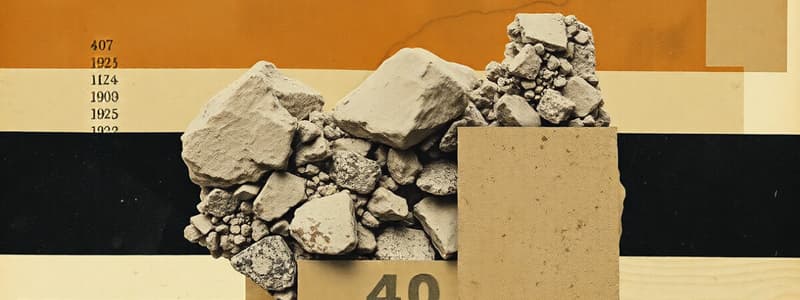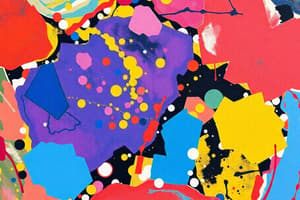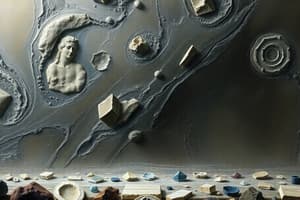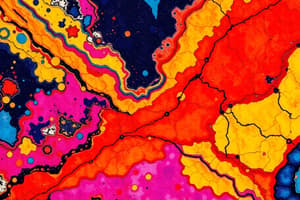Podcast
Questions and Answers
All minerals have the same color.
All minerals have the same color.
False (B)
The way a mineral reflects light is called luster.
The way a mineral reflects light is called luster.
True (A)
Cleavage refers to the way a mineral feels when touched.
Cleavage refers to the way a mineral feels when touched.
False (B)
A mineral with metallic luster looks shiny like a metal.
A mineral with metallic luster looks shiny like a metal.
Streak is always the same color as the mineral.
Streak is always the same color as the mineral.
What is the difference between cleavage and fracture in minerals?
What is the difference between cleavage and fracture in minerals?
Name two tools you can use to test a mineral's hardness.
Name two tools you can use to test a mineral's hardness.
Why is color alone not a reliable property for identifying minerals?
Why is color alone not a reliable property for identifying minerals?
What property is tested by rubbing a mineral on a porcelain tile?
What property is tested by rubbing a mineral on a porcelain tile?
Name three physical properties you can use to identify a mineral.
Name three physical properties you can use to identify a mineral.
Flashcards
Cleavage
Cleavage
The way a mineral breaks along flat, smooth surfaces.
Fracture
Fracture
The way a mineral breaks along irregular or rough surfaces.
Streak
Streak
The color of a mineral's powder when rubbed against a streak plate.
Luster
Luster
Signup and view all the flashcards
Hardness
Hardness
Signup and view all the flashcards
Mohs Hardness Scale
Mohs Hardness Scale
Signup and view all the flashcards
Metallic Luster
Metallic Luster
Signup and view all the flashcards
Non-Metallic Luster
Non-Metallic Luster
Signup and view all the flashcards
Mineral Hardness < 2.5
Mineral Hardness < 2.5
Signup and view all the flashcards
Mineral Hardness 6
Mineral Hardness 6
Signup and view all the flashcards
Quartz
Quartz
Signup and view all the flashcards
Diamond
Diamond
Signup and view all the flashcards
Talc
Talc
Signup and view all the flashcards
Definition of a mineral
Definition of a mineral
Signup and view all the flashcards
Mineral Identification
Mineral Identification
Signup and view all the flashcards
Color is not reliable
Color is not reliable
Signup and view all the flashcards
Cleavage vs. Fracture
Cleavage vs. Fracture
Signup and view all the flashcards
Streak Test
Streak Test
Signup and view all the flashcards
Streak is more reliable than color
Streak is more reliable than color
Signup and view all the flashcards
Minerals in Rocks
Minerals in Rocks
Signup and view all the flashcards
Rocks are made of minerals
Rocks are made of minerals
Signup and view all the flashcards
Igneous rocks
Igneous rocks
Signup and view all the flashcards
Sedimentary rocks
Sedimentary rocks
Signup and view all the flashcards
Metamorphic rocks
Metamorphic rocks
Signup and view all the flashcards
Rock cycle
Rock cycle
Signup and view all the flashcards
Importance of Mineral Properties
Importance of Mineral Properties
Signup and view all the flashcards
Where minerals are found
Where minerals are found
Signup and view all the flashcards
Mineral Uses
Mineral Uses
Signup and view all the flashcards
Mineral Importance for Health
Mineral Importance for Health
Signup and view all the flashcards
Cleavage of a Mineral
Cleavage of a Mineral
Signup and view all the flashcards
Fracture of a Mineral
Fracture of a Mineral
Signup and view all the flashcards
Streak of a Mineral
Streak of a Mineral
Signup and view all the flashcards
Luster of a Mineral
Luster of a Mineral
Signup and view all the flashcards
Hardness of a Mineral
Hardness of a Mineral
Signup and view all the flashcards
What is a Mineral?
What is a Mineral?
Signup and view all the flashcards
Why Color Isn't Reliable
Why Color Isn't Reliable
Signup and view all the flashcards
Streak is More Reliable
Streak is More Reliable
Signup and view all the flashcards
Streak Plate
Streak Plate
Signup and view all the flashcards
Scratching for Hardness
Scratching for Hardness
Signup and view all the flashcards
Talc: Softest
Talc: Softest
Signup and view all the flashcards
Diamond: Hardest
Diamond: Hardest
Signup and view all the flashcards
Quartz: Hard
Quartz: Hard
Signup and view all the flashcards
Importance of Mineralogy
Importance of Mineralogy
Signup and view all the flashcards
Mineralogy
Mineralogy
Signup and view all the flashcards
Study Notes
Physical Properties of Minerals
- Minerals have various physical properties used for identification
- Hardness is a mineral's resistance to scratching
- Luster describes how a mineral reflects light, with examples like metallic, non-metallic, glassy, or dull
- Color isn't always reliable for identification due to impurities
- Streak is the color of a mineral's powder
- Cleavage describes how a mineral breaks along flat surfaces
- Fracture describes how a mineral breaks in an irregular way
Hardness Measurement
- The Mohs Hardness Scale measures a mineral's resistance to scratching
- Minerals are ranked from 1 (softest, talc) to 10 (hardest, diamond)
Mineral Properties
- Luster: Describes how light reflects off a mineral's surface (metallic, non-metallic, glassy, dull, etc.)
- Color: Not a reliable identifier on its own, due to impurities
- Streak: The color of a mineral's powder when rubbed against a hard surface.
- Cleavage: The way a mineral breaks along flat surfaces.
- Fracture: The way a mineral breaks in an irregular pattern.
Mineral Identification
- Use a variety of physical properties to reliably identify minerals
- Testing different properties, like hardness, luster, color, streak, cleavage, or fracture, allows for a more accurate identification.
Studying That Suits You
Use AI to generate personalized quizzes and flashcards to suit your learning preferences.




